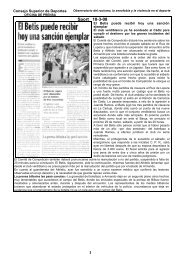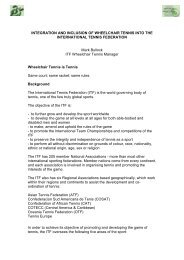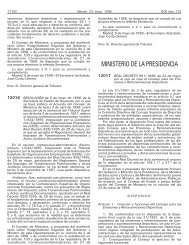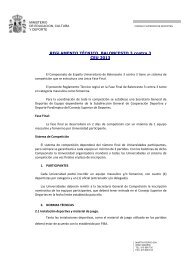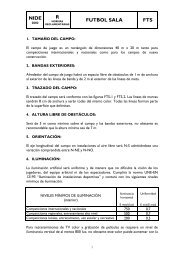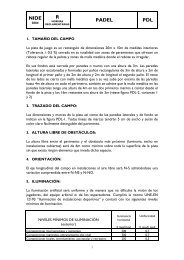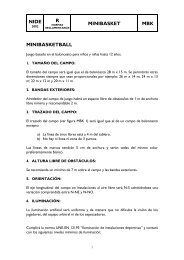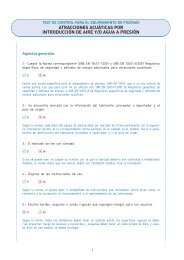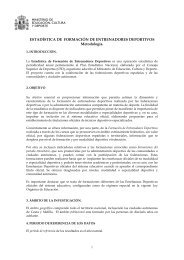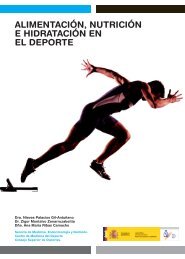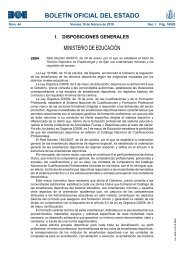VOL Voleibol - Consejo Superior de Deportes
VOL Voleibol - Consejo Superior de Deportes
VOL Voleibol - Consejo Superior de Deportes
Create successful ePaper yourself
Turn your PDF publications into a flip-book with our unique Google optimized e-Paper software.
NIDE<br />
2002<br />
R<br />
NORMAS<br />
REGLAMENTARIAS<br />
1. TAMAÑO DEL CAMPO:<br />
<strong>VOL</strong>EIBOL /<br />
BALON<strong>VOL</strong>EA<br />
1<br />
<strong>VOL</strong><br />
El campo <strong>de</strong> juego es un rectángulo <strong>de</strong> dimensiones 18 m x 9 m, tanto para<br />
competiciones internacionales y nacionales como para los campos <strong>de</strong> nueva<br />
construcción, medidas <strong>de</strong>s<strong>de</strong> el bor<strong>de</strong> exterior <strong>de</strong> las líneas que <strong>de</strong>limitan el campo <strong>de</strong><br />
juego.<br />
2. BANDAS EXTERIORES:<br />
Alre<strong>de</strong>dor <strong>de</strong>l campo <strong>de</strong> juego habrá una banda <strong>de</strong> seguridad libre <strong>de</strong> obstáculos <strong>de</strong> 3<br />
m <strong>de</strong> ancho por cada lado.<br />
En competiciones mundiales <strong>de</strong> la Fe<strong>de</strong>ración Internacional <strong>de</strong> <strong>Voleibol</strong> (FIVB) la zona<br />
libre <strong>de</strong>be medir 5 m <strong>de</strong>s<strong>de</strong> las líneas laterales y 8 m <strong>de</strong>s<strong>de</strong> las líneas <strong>de</strong> fondo.<br />
3. TRAZADO DEL CAMPO:<br />
El trazado <strong>de</strong>l campo <strong>de</strong> juego será conforme con la figura <strong>VOL</strong>-1. Las líneas <strong>de</strong> marcas<br />
tendrán 5 cm <strong>de</strong> ancho, serán <strong>de</strong> color claro y fácilmente distinguible <strong>de</strong>l pavimento.<br />
En Competiciones Mundiales <strong>de</strong> la FIVB las líneas <strong>de</strong>ben ser <strong>de</strong> color blanco.<br />
Todas las líneas forman parte <strong>de</strong> la superficie que <strong>de</strong>limitan.<br />
4. ALTURA LIBRE DE OBSTÁCULOS:<br />
Será <strong>de</strong> 7m como mínimo sobre el campo y las bandas exteriores.<br />
Para competiciones mundiales <strong>de</strong> la FIVB la altura libre <strong>de</strong>be ser como mínimo <strong>de</strong> 12,5<br />
m.<br />
5. ORIENTACIÓN:<br />
El eje longitudinal <strong>de</strong>l campo en instalaciones al aire libre será N-S admitiéndose una<br />
variación comprendida entre N-NE y N-NO.<br />
6. ILUMINACIÓN:<br />
La iluminación artificial será uniforme y <strong>de</strong> manera que no dificulte la visión <strong>de</strong> los<br />
jugadores, <strong>de</strong>l equipo arbitral ni <strong>de</strong> los espectadores. Cumplirá la norma UNE-EN<br />
12193 “Iluminación <strong>de</strong> instalaciones <strong>de</strong>portivas” y contará con los siguientes niveles<br />
mínimos <strong>de</strong> iluminación:
NIDE<br />
2002<br />
R<br />
NORMAS<br />
REGLAMENTARIAS<br />
NIVELES MÍNIMOS DE ILUMINACIÓN<br />
(interior)<br />
<strong>VOL</strong>EIBOL /<br />
BALON<strong>VOL</strong>EA<br />
2<br />
Iluminancia<br />
horizontal<br />
E med (lux)<br />
<strong>VOL</strong><br />
Uniformidad<br />
E min/E med<br />
Competiciones mundiales y oficiales <strong>de</strong> la FIVB<br />
(medido a 1m sobre la zona <strong>de</strong> juego)<br />
1000/1500 0,7<br />
Competiciones nacionales 750 0,7<br />
Competiciones regionales, entrenamiento alto nivel 500 0,7<br />
Competiciones locales, entrenamiento, uso escolar y recreativo 200 0,5<br />
Las luminarias no <strong>de</strong>ben situarse en la parte <strong>de</strong>l techo que esté encima <strong>de</strong>l área <strong>de</strong> la<br />
red.<br />
Para retransmisiones <strong>de</strong> TV color y grabación <strong>de</strong> películas se requiere un nivel <strong>de</strong><br />
iluminancia vertical <strong>de</strong> al menos 800 lux, no obstante este valor pue<strong>de</strong> aumentar con la<br />
distancia <strong>de</strong> la cámara al objeto. Para mayor información <strong>de</strong>be consultarse la norma<br />
citada.<br />
NIVELES MÍNIMOS DE ILUMINACIÓN<br />
(exterior)<br />
Iluminancia<br />
horizontal<br />
E med (lux)<br />
Uniformidad<br />
E min/E med<br />
Competiciones internacionales y nacionales 500 0,7<br />
Competiciones regionales, entrenamiento alto nivel 200 0,6<br />
Competiciones locales, entrenamiento, uso escolar y recreativo 75 0,5<br />
7. PAVIMENTO DEPORTIVO:<br />
La superficie <strong>de</strong> juego <strong>de</strong>be ser una superficie plana, horizontal y uniforme, no son<br />
admisibles superficies rugosas o resbaladizas.<br />
Son aptos los pavimentos sintéticos o <strong>de</strong> ma<strong>de</strong>ra, fijos o <strong>de</strong>smontables. Los pavimentos<br />
rígidos no son recomendables. En Competiciones Mundiales y Oficiales <strong>de</strong> la FIVB solo<br />
se permiten superficies <strong>de</strong> ma<strong>de</strong>ra o sintética.<br />
El pavimento <strong>de</strong>portivo cumplirá los siguientes requisitos <strong>de</strong> acuerdo con el Informe<br />
UNE 41958 IN “Pavimentos <strong>de</strong>portivos”
NIDE<br />
2002<br />
R<br />
NORMAS<br />
REGLAMENTARIAS<br />
REQUISITOS:<br />
Absorción impactos<br />
(Reducción <strong>de</strong> fuerza)<br />
Deformación<br />
Fricción<br />
Planeidad<br />
Resistencia a impactos<br />
Resistencia a huella<br />
Cargas rodantes<br />
Resistencia a abrasión<br />
Espesores<br />
Resistencia al fuego<br />
RF≥35%<br />
RF≥20%<br />
S tV≤3mm<br />
S tV≤5mm<br />
<strong>VOL</strong>EIBOL /<br />
BALON<strong>VOL</strong>EA<br />
3<br />
<strong>VOL</strong><br />
Competiciones ámbito internacional y nacional<br />
Competiciones ámbito regional, local, recreativo y<br />
escolar<br />
0,4≤µ≤0,8<br />
Sintético<br />
Ma<strong>de</strong>ra<br />
Diferencias <strong>de</strong> nivel inferiores a 3 mm medidos con regla <strong>de</strong> 3 m<br />
(1/1000)<br />
Sin fisuras, grietas o <strong>de</strong>formaciones mayores <strong>de</strong> 0,5 mm para impactos<br />
<strong>de</strong> 8 Nm<br />
Sin fisuras, grietas o <strong>de</strong>formaciones mayores <strong>de</strong><br />
0,5 mm a las 24 h. <strong>de</strong> realizar el ensayo<br />
Sin fisuras, grietas o <strong>de</strong>formaciones mayores <strong>de</strong><br />
0,5 mm para cargas <strong>de</strong> 1500 N (ma<strong>de</strong>ra)<br />
o para carga <strong>de</strong> 1000 N (sintético)<br />
Máxima perdida <strong>de</strong> peso: 3 g por 1000 revoluciones (sintético)<br />
Verificación <strong>de</strong>l espesor o espesores <strong>de</strong> las capas, ofrecidos por el<br />
fabricante o instalador, <strong>de</strong> acuerdo con la norma UNE EN 1969<br />
M3 (UNE 23727)<br />
En pistas cubiertas el color <strong>de</strong>l pavimento <strong>de</strong>be ser claro.<br />
Para pistas exteriores a<strong>de</strong>más <strong>de</strong> los anteriores cumplirán los siguientes requisitos:<br />
Pendientes <strong>de</strong> evacuación<br />
Resistencia a tracción (sintéticos)<br />
Alargamiento <strong>de</strong> rotura (sintéticos)<br />
Drenaje (Pavimentos drenantes)<br />
Transversal y máxima <strong>de</strong>l 0,5%<br />
(5 mm por metro)<br />
≥400 KPa<br />
≥ 40 %<br />
Coeficiente <strong>de</strong> infiltración >50 mm/h
NIDE<br />
2002<br />
R<br />
NORMAS<br />
REGLAMENTARIAS<br />
8. TEMPERATURA AMBIENTE:<br />
<strong>VOL</strong>EIBOL /<br />
BALON<strong>VOL</strong>EA<br />
4<br />
<strong>VOL</strong><br />
No <strong>de</strong>be ser inferior a 10° C. En competiciones mundiales FIVB no <strong>de</strong>berá ser inferior<br />
a 16° C ni exce<strong>de</strong>r <strong>de</strong> 25° C.<br />
9. EQUIPAMIENTO:<br />
El equipamiento consta <strong>de</strong> los postes, la red y las antenas. Cumplirán las Reglas<br />
oficiales <strong>de</strong> la Real Fe<strong>de</strong>ración Española <strong>de</strong> <strong>Voleibol</strong> y la norma UNE EN 1270 “Equipos<br />
<strong>de</strong> balonvolea”.<br />
LA RED:<br />
La red (ver figura <strong>VOL</strong>-2) será <strong>de</strong> fibras sintéticas, con dimensiones <strong>de</strong> 1 m <strong>de</strong> ancho y<br />
9,50 m <strong>de</strong> largo con malla negra a cuadros <strong>de</strong> 10 cm x 10 cm con banda superior<br />
horizontal <strong>de</strong> 7 cm <strong>de</strong> ancho, <strong>de</strong> color blanco. Por su interior pasará un cable <strong>de</strong><br />
sujeción <strong>de</strong> la red, a<strong>de</strong>más tendrán una cuerda <strong>de</strong> tensado superior y en el extremo<br />
inferior otra cuerda <strong>de</strong> tensado inferior.<br />
Verticalmente se colocan en la red dos bandas laterales <strong>de</strong> 5 cm <strong>de</strong> ancho y 1 m <strong>de</strong><br />
largo que van sobre cada línea lateral <strong>de</strong>l campo <strong>de</strong> juego.<br />
La altura <strong>de</strong> la red se indica en el cuadro adjunto y se mi<strong>de</strong>n <strong>de</strong>s<strong>de</strong> el centro <strong>de</strong>l<br />
campo. La altura por encima <strong>de</strong> las dos líneas laterales <strong>de</strong>be ser la misma y no <strong>de</strong>be<br />
exce<strong>de</strong>r mas <strong>de</strong> 2 cm <strong>de</strong> la altura oficial.<br />
ANTENAS:<br />
ALTURA DEL BORDE SUPERIOR DE LA RED<br />
(m)<br />
CATEGORIA MASCULINA FEMENINA<br />
Seniors<br />
2,43 2,24<br />
Juveniles<br />
(16 y 17 años)<br />
Ca<strong>de</strong>tes<br />
(14 y 15 años)<br />
Infantiles<br />
(12 y 13 años)<br />
Alevines<br />
(10 y 11 años)<br />
Benjamines<br />
(8 y 9 años)<br />
2,43 2.24<br />
2,37 2,18<br />
2,24 2,10<br />
2,10 -<br />
2,00 -<br />
Son dos varillas <strong>de</strong> plástico reforzado con fibra <strong>de</strong> vidrio ó similar <strong>de</strong> 10 mm <strong>de</strong><br />
diámetro y 1,80 m <strong>de</strong> largo, colocadas a ambos extremos <strong>de</strong> la red al exterior <strong>de</strong> cada<br />
banda lateral (Ver figura <strong>VOL</strong>- 2) para <strong>de</strong>limitar los límites <strong>de</strong>l área por don<strong>de</strong> pue<strong>de</strong><br />
jugarse el balón.
NIDE<br />
2002<br />
R<br />
NORMAS<br />
REGLAMENTARIAS<br />
<strong>VOL</strong>EIBOL /<br />
BALON<strong>VOL</strong>EA<br />
5<br />
<strong>VOL</strong><br />
Se dispondrán siempre en competiciones nacionales o internacionales y es optativo su<br />
utilización para uso escolar, recreativo o entrenamiento.<br />
POSTES:<br />
Serán redondos, situados entre 0,5 y 1 m <strong>de</strong> las líneas laterales (en competiciones<br />
internacionales y <strong>de</strong> la FIVB estarán a 1 m) y tendrán una altura <strong>de</strong> 2,55 m (ver figura<br />
<strong>VOL</strong>-2)<br />
Deben estar fijados firmemente al suelo sin cables. Esta fijación pue<strong>de</strong> ser mediante<br />
cajetines empotrados en el suelo en un macizo <strong>de</strong> hormigón un mínimo <strong>de</strong> 35 cm o<br />
con anclaje a suelo sobre bases, en este caso dichas bases <strong>de</strong>ben estar fuera <strong>de</strong>l campo<br />
<strong>de</strong> juego y <strong>de</strong>ben protegerse para evitar riesgos durante el juego (ver figura <strong>VOL</strong>-3)<br />
Para competiciones internacionales y nacionales se <strong>de</strong>ben proteger los postes con un<br />
material amortiguador hasta 2 m <strong>de</strong> altura, el cual cumplirá la norma UNE EN 913<br />
siendo el valor <strong>de</strong> amortiguamiento con una caída <strong>de</strong> 200 mm inferior a 50 g<br />
(aceleración <strong>de</strong> la gravedad 9,8 m/s²) Es recomendable disponer siempre dicha<br />
protección.<br />
EL BALÓN:<br />
Esférico, con superficie exterior <strong>de</strong> cuero flexible o sintética y con cámara interior <strong>de</strong><br />
caucho ó similar (figura <strong>VOL</strong>-4)<br />
La circunferencia <strong>de</strong>l balón será <strong>de</strong> 65 cm a 67 cm y su peso <strong>de</strong> 260 g a 280 g. La<br />
presión interior <strong>de</strong>l balón será <strong>de</strong> 0,30 a 0,325 Kg/cm² (294,3 a 318,82 mbar o hPa,<br />
4,26 a 4,62 psi)



